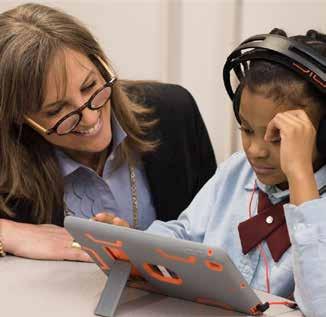
6 minute read
Why Nonprofit Leaders Need
from Business Journal 163
by d-mars.com
EDUCATION & CAREER Why Nonprofit Leaders
Need To Lead The Way In Innovating Education
By d-mars.com News Provider
Founder of LiteracyMatters.org, a foundation on a mission to close the literacy gap with scalable, ethical technology & evidence-based instruction.
As 2020 came to a close, were you looking at the glass half full, or depending on the day, half empty after almost a year of surviving the pandemic? In 2021, millions of American families will continue to struggle to put food on the table, while others will have children set up, sitting up, and eager to join virtual classmates and teachers, in Zoom classrooms across this nation. If they have access to the internet and equity in education - that's a big, powerful word - if. And if not now, when?
When the vaccine makes its way across the country and schools hopefully reopen, there is a question we will have to address as a nation: What becomes of the preexisting condition and national crisis of illiteracy that continues to destroy the future of our nation's children? How many children have fallen even further behind this year because we did not innovate to educate, reach and teach all children how and where they learn?
According to research from Gallup and the Barbara Bush Foundation for Family Literacy, low adult literacy rates could be costing the U.S. economy $2.2 trillion in GDP. The research found that roughly 130 million adults in the U.S. are "reading below the equivalent of a sixth grade level." Reading levels in grade schoolaged children have been stagnating and even dropping off. In 2019, national average reading scores for fourth and eighth graders were slightly below average reading scores in 2017.
Whether we look at the data on our failing education systems as a travesty of justice or from the lens of an economist astounded by the loss of human capital, there
Photo Caption: Deb Mallin, Forbes Councils Member
are questions we should be asking. If the definition of insanity is doing the same thing over and over and expecting a different outcome, we should apply this principle to our education efforts.
Why haven't today's classrooms changed much in the way they look and operate over the past several decades? Why, in 2020, in this rapidly advancing, digital age of technology and machine learning and AI, are we still teaching children as though they rode to school in a horse-drawn buggy? We scaled Braille across this nation in 1918, during the time of the candlestick phone and the 1918 flu pandemic. Why can't we provide the fundamental skills of literacy, a sound-to-symbol and symbol-to-sound system that teaches the English language?
Who benefits when children are unable to move from learning to read to reading to learn? Access to evidence-based, whole child-centered learning is not a pie. We don't need to ration piece by piece when we have the ability to democratize education. There is more than enough pie for everyone. We all do better when we all do better.
As nonprofit leaders, we have the immense responsibility to redefine and rethink how we approach our education initiatives. I challenge you as leaders to rethink how we provide sustainable systems change, starting with acknowledging that our efforts are dramatically diminished if we continue to work in silos. Collaboration, partnerships and coalitions offer us opportunities to strengthen our impact by harnessing the power and resources our fellow nonprofits have to offer.
As leaders in the education space, let's commit to supporting the best of both proven and innovative ways of approaching this generation's national epidemic of illiteracy. I believe we can deconstruct the problem and mobilize an all-American effort to provide equity in education, with teachers properly trained in the science of literacy instruction, scalable individualized curriculum and the use of ethical technology that makes it all possible.
Another crucial element to our efforts is to educate ourselves on political candidates, state budget proposals and public-private partnerships that commit to targeted and accountable literacy education initiatives. We are the players who can evoke real change and advocate for greater education in-roads. The ROI isn't just for the children we'll teach. It's exponentially significant to the donors who invest in our nonprofits - and for society as a whole.
As a nation, we can accept the hierarchy of responsibility and work together to make 2021 be the year we apply the lessons learned from the pandemic and scale literacy and justice for all.
Sources: BPT Forbes Nonprofit Council
EDUCATION & CAREER
Boosting Your Child’s Confidence Can Help Them Land a Tech Job
By d-mars.com News Provider
Confidence is a great thing. It can make people more open to learning new skills, pursuing new opportunities and living new experiences. When it comes to career choices, confidence, or rather a lack of it, can keep qualified and motivated individuals from even considering certain fields. Technology is at the forefront of this dilemma, according to those in the industry, who also note that lingering misconceptions may be widening a “confidence gap.”
“For too long we’ve been telling young people that the best jobs of the future will require advanced degrees in science, technology, engineering or math,” said Todd Thibodeaux, president and CEO of CompTIA, the Computing Technology Industry Association. “The reality is that the vast majority of good paying jobs in the next 30 years won’t require a STEM degree.
“Unfortunately, many students have concluded that they don’t have the qualifications or skills to work in tech, creating a confidence gap that contributes to the lack of diversity in the tech workforce,” Thibodeaux continued. “To close this gap we need employers to open the door to more candidates with non-traditional backgrounds, and for parents and role models to encourage all young people to look at opportunities in tech when they think about their career options.”
Thibodeaux explains that a great first step is to speak with young people in plain and simple language about what a career in technology truly entails. That includes making sure they understand that working in tech isn’t always about engineering, coding, calculus and Silicon Valley. It’s also about customer service, teamwork, curiosity, communication and problem solving. It means working for any size company in any industry and in any location.
Equally important, young people need to know about the many resources available to them to learn about careers in tech, network with others who share their interests and acquire the skills that will help them land a job. Here are a few examples:

• The Technology Student Association is a national, nonprofit career and technical student organization of 250,000-plus middle school and high school students that offers exciting opportunities in networking, competitions, leadership and community service. For more information, visit tsaweb.org
• The National Cyber League offers students of all ages game-meetsedutainment competitions simulating real-life cyberthreats in a safe environment so students can learn how to defend against threats. To learn more, visit nationalcyberleague.org • TechGirlz inspires middle school girls to explore the possibilities of technology through the creation of free, fun, interactive “TechShopz” led by industry professionals, community leaders and students. Get the details at techgirlz.org.
The tech industry is in the midst of a massive new wave of innovation. Advances in renewable energy, artificial intelligence, bionics, robotics, healthcare and many other areas are changing virtually every walk of life. To turn these possibilities into realities, millions of knowledge workers and technology professionals will be needed.
“Don’t think that you need to be a math or science genius or that you need to have coding skills or that if you’re not good at ‘computational thinking’ you don’t have a chance. All you need is confidence in yourself,” says Thibodeaux.








